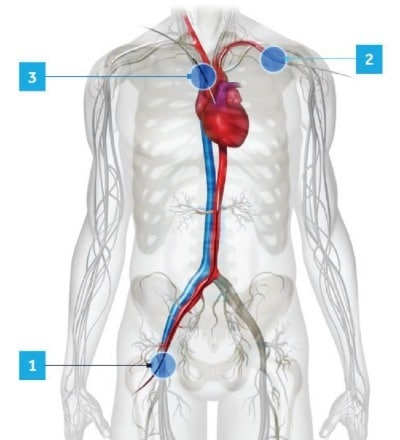TAVR & Aortic Stenosis at Platte Valley Medical Clinic
TAVR Procedure
In the Medtronic TAVR procedure, a thin, flexible tube (catheter) is inserted into one of several access routes:
• An artery in your groin (1)
• An artery in your neck (2)
• A space between your ribs (3)
Throughout the procedure, you will be under anesthesia or sedation. A temporary pacemaker will be inserted to allow your doctor to control your heart rate as needed.

The arteries in your body are like a system of roads that branch out from the heart. There are different “routes” that your doctor can use to implant the Medtronic heart valve.
About Aortic Stenosis
Aortic Stenosis is one of the most common and serious valve disease problems. The heart pumps blood through the aortic valve to the rest of the body. Over time, calcium can build up on the aortic valve which can cause difficulty with valve opening and may restrict blood flow to the body.

Aortic Stenosis makes your heart work harder to push the blood through the diseased valve, it can cause symptoms such as chest pains, tiredness, shortness of breath, lightheadedness, and fast or fluttering heart beats. Aortic stenosis is more common in individuals over the age of 65, affecting 10% of this population. If left untreated, it can lead to heart failure and death. Aortic stenosis is identified by your healthcare provider on physical examination by listening to you heart, you may be told you have a heart murmur. Further evaluation of severity of aortic stenosis is done with an echocardiogram or “echo.”
If your provider feels you have aortic stenosis, then referral to our structural heart clinic may be recommended.
Treatment Options
1. Surgical replacement of valve
2. Transcatheter replacement of valve
3. Medical management
Surgical Aortic Valve Replacement (SAVR) is open heart surgery where your aortic valve is removed and replaced with a new valve. SAVR involves an incision through the breastbone to access the heart for valve replacement. Hospital stay is typically 3-6 days. Recovery time is generally 4-7 weeks. You might be required to be on anticoagulation depending on the type of valve replacement. Younger patients may benefit from SAVR given considerations with your valve anatomy and overall long-term valve durability.
Transcatheter Aortic Valve Replacement (TAVR) is a less invasive procedure where a small catheter (tube) is inserted through an artery, typically in the leg, and a new valve is then advanced through your aortic valve and opened up. TAVR does not require an incision through the chest. Hospital stay is typically 1-2 days. Recovery time is generally 7-10 days with minimal activity restrictions at home. Typically no anticoagulation is required after the procedure, unless you are already on for another reason.
Medical management involves no invasive procedure. Typically this is managed by your general cardiologist. Medical management involves use of additional medications to treat symptoms of aortic stenosis.

